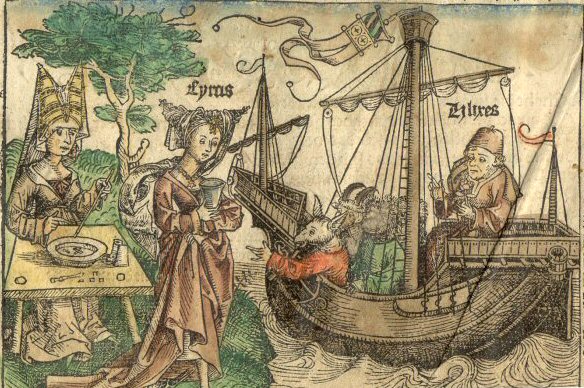Nuremberg Chronicle (Schedel's World History)
The examples below in German, printed 1493

|
Hartmann Schedel (1440-1514), was a native of Nuremberg, and first studied in Leipzig from 1456 to 1462, obtaining the degree of Master of Arts (Magister Artium), before moving to Padua, Italy to continue his humanistic studies and also to study medicine. His great passion in life was books. His library, most of which still survives, consisted of 370 manuscripts (many of them copied out by himself) and 670 printed books, a huge amount for that time. It was this library that formed the basis of the Nuremberg Chronicle. The Nuremberg Chronicle was first published 1493 in Latin and German. This was the year that Columbus arrived back after his first trip to the New World. It's hardly surprising then, that the Chronicle looks to the Old World and back to the narrative tradition of medieval universal chronicles. The book follows a biblical framework although biblical and non-biblical historical events are often interwoven with lengthy digressions on the subject of natural catastrophes, wars, reports of the founding of cities, etc. The book was printed by Anton Koberger. The two artists who were responsible for overseeing the design and illustration of the Chronicle were Michael Wohlgemut (1434-1519) and his stepson Wilhelm Pleydenwurff (c. 1450-1494). The young Albrecht Dürer (1471-1528), was Michael Wohlgemut's apprentice, and trained in his workshop from 1486-1489, when many of the early designs for the illustrations of the Chronicle were created. There are a large number of woodcuts used in the book. Many were moved around in the book so that they were used 2 or 3 times to illustrate different characters (with the same image!). It is estimated that approximately 1400-1500 Latin copies and 700-1000 German ones were printed. Books printed before 1500 are often called "Incunabula" from the Latin for "cradle".
"When Ulysses[Ulixes] (as Augustinus and Boecius write) returned from the Trojan War he travelled ten years over the sea and finally came to Italy next to Sicily to an island, there lived Circe, the black sorceress, a very beautiful woman, who was called the daughter of the sun. She made by her skill and sorcery a drink by which - according to her intention - all who drank from it were transformed from human nature into beastlike shape. Now she handed this drink to the companions of Ulysses and turned so one of them into a wild pig, this into a lion, the other into a stag. But Mercurius has given Ulysses a flower which served against such skill and sorcery. And because she couldn't do harm to him he compelled her with his bare sword to bring his companions to their former shape. Solinus writes: This Ulysses has built the city of Olissipo [Lisbon] in Spain and called after him."
Early Printed Books - Introduction 1493 Nuremberg Chronicle (Schedel's World History) [THIS PAGE] 1572 The Wittenberg Bible 1588 Michael Eytzinger: Of Leone Belgico, eiusque topographica atque historica.. 1617 Theodore de Bry: Grand Voyages to the New World -Introduction and pages on Raleigh, Drake and Pizarro 1617 Theodore de Bry: Grand Voyages to the New World -Florida and the French: le Moyne's pictures 1617 Theodore de Bry: Grand Voyages to the New World -Mexico |
 This page describes, with appropriate pictures, "Saul, the first king of the Jews", David, Samuel, Jonathon and others.
This page describes, with appropriate pictures, "Saul, the first king of the Jews", David, Samuel, Jonathon and others.
 More on Samuel and other kings, prophets and judges. Sampson is seen top right holding, presumably, the broken gates of the temple he has pulled down. Samuel is shown with his mother Hannah (Anna). She holds a branch on the end of which is a flower on which Samuel is sitting. This device is used throughout the book to show a "family tree" connection.
More on Samuel and other kings, prophets and judges. Sampson is seen top right holding, presumably, the broken gates of the temple he has pulled down. Samuel is shown with his mother Hannah (Anna). She holds a branch on the end of which is a flower on which Samuel is sitting. This device is used throughout the book to show a "family tree" connection. Some of the kings of Persia are shown: Darius, Cyrus, Cambyses and Smerdis. Also pictured/described are Nehemias who was commissioned by Artaxerxes to rebuild Jerusalem and Mardocheus from the Biblical Book of Esther.
Some of the kings of Persia are shown: Darius, Cyrus, Cambyses and Smerdis. Also pictured/described are Nehemias who was commissioned by Artaxerxes to rebuild Jerusalem and Mardocheus from the Biblical Book of Esther.
 This is a history of early Republican Rome. Mentioned/pictured are Tarquin the Proud, the last king, Publius Valerius Poplicola and L. Junius Brutus (ancestor of the famous Brutus), the founder of the Republican constitution. Top right is the Sibyl who burnt the Sibylline Oracles one by one until Tarquin was forced to buy the last ones.
This is a history of early Republican Rome. Mentioned/pictured are Tarquin the Proud, the last king, Publius Valerius Poplicola and L. Junius Brutus (ancestor of the famous Brutus), the founder of the Republican constitution. Top right is the Sibyl who burnt the Sibylline Oracles one by one until Tarquin was forced to buy the last ones.